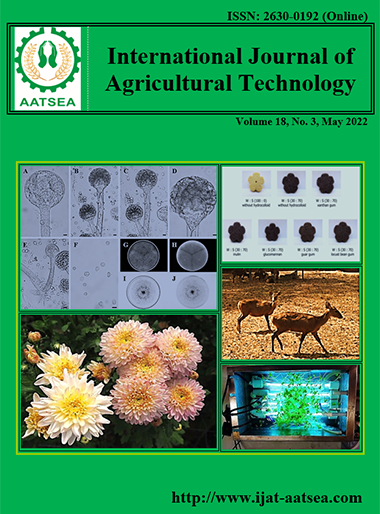Prediction of optimal inclusion levels of neem leaf meal that supports spermatogenesis in rabbits using quadratic optimisation model
Main Article Content
Abstract
This study was designed to assess the effect of neem (Azadirachta indica A. Juss) leaf meal (NLM) on reaction time and semen quality characteristics of male rabbits. A total of 36 New Zealand white × Chinchilla male rabbits aged 7-8 months were randomly assigned to four dietary treatments designated 0, 5, 10 and 15% NLM with three replications, each having three rabbits for 16 weeks. Semen volume, sperm motility, sperm concentration, total sperm production, abnormal sperm percent and reaction time were assessed at week 4, and thereafter at weeks 6, 8, 10, 12, 14 and 16. Duncan’s test for multiple comparisons was used to test the significant difference between treatment means (p < 0.05). A quadratic equation was used to determine dietary NLM inclusion levels for optimum parameters which were significantly different. Results indicate that addition of NLM at 0.71% supported optimum sperm concentration (12.58 + 1.80 NLM - 1.27 NLM2; p = 0.02). This was higher than the levels of 0.24% and 0.69% needed to improve sperm motility (77.78 – 0.99 NLM – 2.07 NLM2; p = 0.01) and total sperm concentration (14.60 + 0.94 NLM – 0.68 NLM2; p = 0.01), respectively in male rabbits. However, a value of 0.85% NLM gave the least abnormal sperm percent (11.43 – 2.06 NLM + 1.22 NLM2; p = 0.01). It is suggested that dietary NLM inclusion levels of 0.24 – 0.85% supported spermatogenesis in male rabbits. Thus, optimizing the NLM inclusion level in the diet of male rabbits could help to enhance their reproductive efficiency.
Article Details

This work is licensed under a Creative Commons Attribution-NonCommercial-NoDerivatives 4.0 International License.
References
Alabi, O. J., Ng'ambi, J. W. and Norris, D. (2013). Dietary energy level for optimum productivity and carcass characteristics of indigenous Venda chickens raised in closed confinement. South African Journal of Animal Science, 43: S75-S80.
Al-Hashemi, Z. S. S. and Hossain, M. A. ( 2016). Biological activities of different neem leaf crude extracts used locally in ayurvedic medicine Pacific Science Review. A Natural Science and Engineering, 18:128-131.
Ayuba, F., Ayoade, J. A., Orayaga, K. T. and Emmanuel, S. S. (2021). Effect of feeding sun-dried neem (Azadirachta indica) leaf meal on growth performance and economic of production of weaner rabbits. American Research Journal of Humanities Social Science, 4:40-45.
Esonu, B. O., Opara, M. N., Okoli, I. C., Obikaonu, H. O., Udedibie, C. and Iheshiulor, O. O. M. (2006). Physiological responses of laying birds to neem (Azadirachta indica) leaf meal-based diets, body weight, organ characteristics and hematology. Life Science Journal, 2:37-41.
Herbert, U. and Adejumo, D. O. (1995). Construction and evaluation of artificial vagina for collecting rabbit semen. Delta Agriculture, 2:99-108.
Jafari, S. (2014). Linear and quadratic effects of individual and ewe inbreeding on greasy fleece weight and reproductive traits of Makuie sheep breed. Slovak Journal of Animal Science, 47: 68-76.
Jimoh, O. A. and Ayedun, E. S. (2020). Quality and fertility of rabbit semen diluted with watermelon juice. Archivos de Zootecnia, 69:140-146.
Mishra, R. K. and Singh, S. K. (2005). Effect of aqueous leaf extract of Azadirachta indica on the reproductive organs in male mice Indian Journal of Experimental Biology, 43:1093-1103.
Muhammad, S. B., Sobayo, R. A., Sogunle, O. M., Oso, A. O. and Adeyemi, O. A. (2015). Variations in haematological and serum indices of finisher broiler birds fed neem (Azadirachta indica) and garlic (Allium sativum) as phytobiotics. Nigerian Journal of Animal Production, 42:129-140.
Ogbuewu, I. P. and Mbajiorgu, C. A. (2020). Supplementation and optimization of ginger (Zingiber officinale) rhizome powder in growing rabbit diets. Indian Journal of Animal Research, 54:1120-124.
Ogbuewu, I. P., Okoli, I. C. and Iloeje, M. U. (2009). Semen quality characteristics, reaction time, testis weight and seminiferous tubule diameter of buck rabbits fed neem (Azadirachta indica A. Juss) leaf meal-based diets. Iranian Journal of Reproductive Medicine, 7:23-28.
Ogundun, N. J., Mbajiorgu, E. F. and Mbajiorgu, C. A. (2013). Dose-response effect of percentage uromalt (M) inclusion level on spermatogenesis in West African dwarf buck-kids. Indian Journal of Animal Research, 47:373-378.
SAS. (2008). SAS Users Guide Version 9.2. 2nd edition, SAS Institute Inc., North Carolina USA.
Sebola, N. A., Mlambo, V., Mokoboki, H. K. and Muchenje, V. (2015). Growth performance and carcass characteristics of three chicken strains in response to incremental levels of dietary Moringa oleifera leaf meal. Livestock Science, 178: 202-208.
Sokunbi, O. A. and Egbunike, G. N. (2000). The performance of growing rabbits fed diets containing sun cured neem leaf meal. Proceedings of the 5th Annual Conference of Animal Science Association of Nigeria, held in Port Harcourt, Nigeria, Sept. 19 -22, pp.113-116.
Ubua, J. A., Ozung, P. O. and Inagu, P. G. (2019). Dietary inclusion of neem (Azadirachta indica) leaf meal can influence growth performance and carcass characteristics of broiler chickens. Asian Journal of Biological Sciences, 12:180-186


